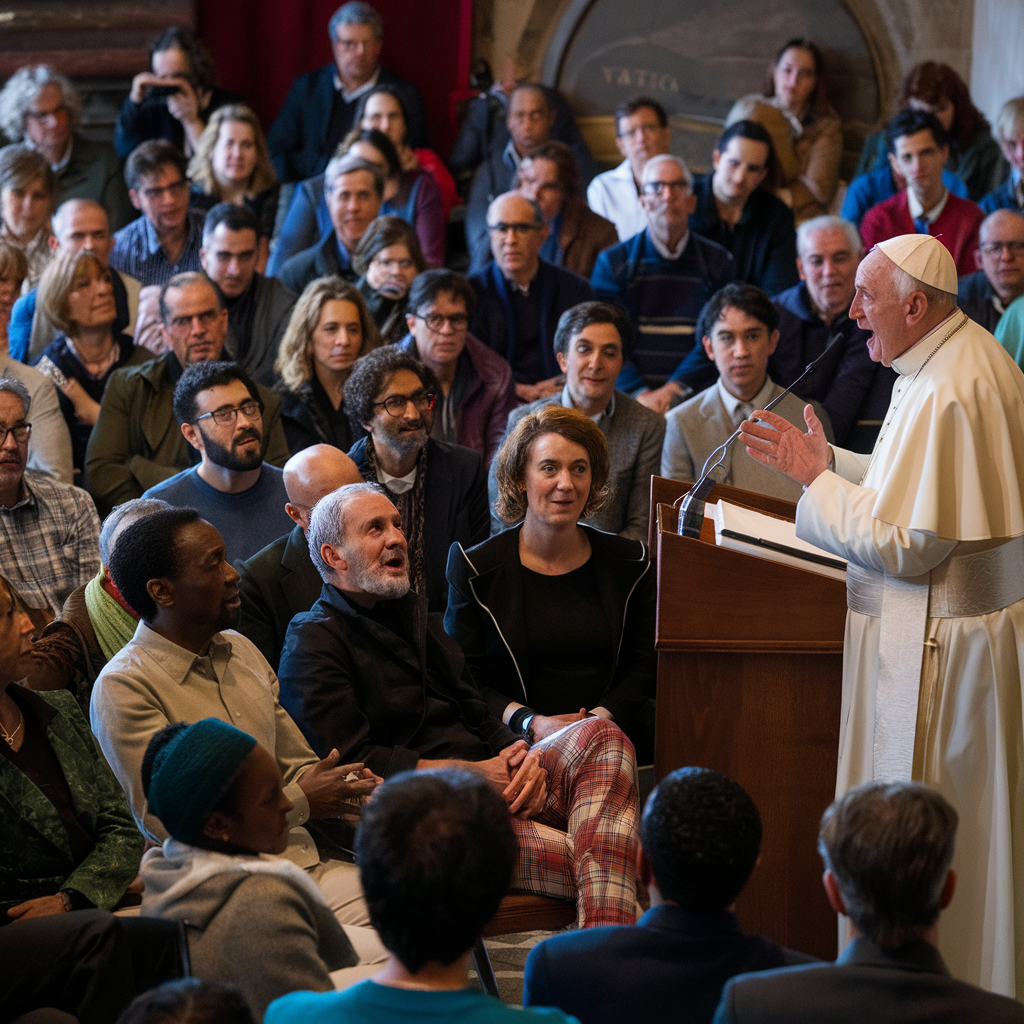“You unite people, because laughter is contagious.” So said Pope Francis at his June 14, 2024, Audience at the Vatican with comedians and artists from the world of humor. International names include Whoopi Goldberg, Jimmy Fallon, Chris Rock, and Conan O’Brien; Italians include Lino Banfi, Christian De Sica, Carlo Verdone, Luciana Littizzetto, Giorgio Panariello, and Geppi Cucciari—an event sponsored by the Holy See’s Dicasteries of Culture, Education, and Communication.
Pope Bergoglio gathered a large number of laughter artists from various continents and, with them, indulged in a reflection on life in contemporary society, an existence often placed under pressures and emergencies, even paralyzing ones. In all this, however, a smile can be a powerful detonator of worries and an amplifier of confidence and hope. “It is easier to laugh together than alone,” the Pontiff remarked, “joy opens us to sharing and is the best antidote to selfishness and individualism. Laughter also helps to break down social barriers, create connections among people. It allows us to express emotions and thoughts, contributing to building a shared culture and creating spaces of freedom.”
This is not the first time the Argentine pope has dwelt on irony and humor’s social and cultural value. Indeed, he has often recalled his attachment to the prayer of St. Thomas More. “I like to pray daily – and I have done this for more than forty years – with the words of Saint Thomas More: ‘Grant me, O Lord, a good sense of humour’.”
In his meditations, there is a constant call to the anchoring of lightness, the need for escapism. And although Pope Francis no longer watches movies, as he has repeatedly stated, there is no shortage of cinematic suggestions in his speeches that call into play precisely the smile. In a dialogue with Msgr. Dario E. Viganò emphasized the relevance of the character of Gelsomina (Giulietta Masina) in the film La strada (1954), a wandering artist dressed as a clown with a sweet and melancholy smile, a figure marked by grace and purity of soul. “It is the film that I perhaps loved the most,” said the Pope, “I identify very much with that film, in which we find an implicit reference to St. Francis […] I think of Gelsomina’s whole journey: with her humility and fully limpid gaze, she softens the hard heart of a man who had forgotten how to weep. This pure gaze of the last can sow life in the driest soils. It is a gaze of hope, which knows how to sense the light in the darkness: that is why it must be treasured” (D.E. Viganò, Lo sguardo: la porta del cuore. Neorealism between memory and actuality. With an interview with Pope Francis on cinema, Effatà Editrice, Cantalupa 2021, p. 16).
The flash of irony radiated by comedy, by the artists of the smile, is like a mustard seed (cf. Mk. 4:31-32) that succeeds in making the future sprout even in harsh soils. As Pope Francis always reminded in the Audience with the artists, “But you also succeed in another miracle: you manage to make people smile even while dealing with problems, small and big facts of history. You denounce abuses of power; you give voice to forgotten situations; you highlight abuses; you point out inappropriate behavior…. But without spreading alarm or terror, anxiety or fear, as much communication does, you awaken the critical sense by making people laugh and smile.”
This underscores the power of humor in addressing societal issues and providing social commentary.
In approaching these words, one’s thoughts certainly go to the biting and compelling gaze of Charlie Chaplin, who, with his film The Great Dictator (1940), was able to unmask the horror and insane violence of Nazi-fascism, the moral and anthropological drift undertaken during World War II. And always moving in the territories of cinema, how can we not recognize the gift in the smile and the art of comedy in declining painful pages of our shared memory: for example, the films that elaborated on the problematic theme of the Shoah by trying to narrate it with educational humor marked by dramatic brushstrokes. Such is the case with Roberto Benigni’s Life is Beautiful (1997), Radu Mihăileanu’s Train de vie (1998), and Taika Waititi’s more recent Jojo Rabbit (2020).
Again, thoughts turn to the use of smiles as a threshold for encountering and understanding the condition of the person with disabilities: this is the significant gain of the cinema of the new Millennium with such eye-catching titles as Almost Friends (Intouchables, 2011) by Olivier Nakache and Éric Toledano, The Signs of the Heart. Tail (Coda, 2021) by Sian Heder, not forgetting the original French version of The Bélier Family (La Famille Bélier, 2014) by Éric Lartigau. Also on the same theme, Bobby Farrelly’s more recent Champions (Champions, 2023) from the Spanish original Non ci resta che vincere (Campeones, 2018) by Javier Fesser.
And so if Pope Francis recalled the prayer of a smile, that of St. Thomas More, it is Charlie Chaplin who delivered to us a “secular prayer” (the reference is the film Modern Times. Modern Times, from 1936) in what later became a famous piece of music, Smile, completed in 1954 by John Turner and Geoffrey Parsons, recorded by Nat King Cole: “Smile, though your heart is aching / Smile, even though it’s breaking / When there are clouds in the sky / you’ll get by / If you smile through your fear and sorrow / Smile and maybe tomorrow / You’ll see the sun come shining through for you.”


